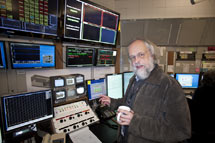
Handy Links
SLAC News Center
SLAC Today
- Subscribe
- Archives: Feb 2006-May 20, 2011
- Archives: May 23, 2011 and later
- Submit Feedback or Story Ideas
- About SLAC Today
SLAC News
Lab News
- Interactions
- Lightsources.org
- ILC NewsLine
- Int'l Science Grid This Week
- Fermilab Today
- Berkeley Lab News
- @brookhaven TODAY
- DOE Pulse
- CERN Courier
- DESY inForm
- US / LHC
SLAC Links
- Emergency
- Safety
- Policy Repository
- Site Entry Form

- Site Maps
- M & O Review
- Computing Status & Calendar
- SLAC Colloquium
- SLACspeak
- SLACspace
- SLAC Logo
- Café Menu
- Flea Market
- Web E-mail
- Marguerite Shuttle
- Discount Commuter Passes
-
Award Reporting Form
- SPIRES
- SciDoc
- Activity Groups
- Library
Stanford
Around the Bay
Springtime for the Linac: The West End Reawakens for FACET
Winter may be just around the corner, but the first two-thirds of SLAC's linear accelerator just woke up from a 20 month hibernation.
After PEP-II and the BaBar experiment shut down in April 2008, the damping rings and Sectors 0 through 20 of the linac went into a so-called "minimum maintenance state" in which the vacuum and cooling water were left on, but just about everything else—including the klystrons and more than 1000 electrically powered magnets—was turned off.
Thanks to significant effort by many in the SLAC community, an electron beam once again began humming through Sectors 0 through 20 last week.
"This is a super achievement," said Uli Wienands, director of the S0-20 Division in the Accelerator Directorate. "We are learning a lot and are working on a list of issues to address during the upcoming downtime, but basically, the gun, accelerator and north damping ring are working."
Beginning in November 2010, the first two-thirds of the linac will provide beam to FACET, the Facilities for Accelerator Science and Experimental Test Beams, located in the linac tunnel at Sector 20. There, researchers will test next-generation particle accelerator concepts. (For more on FACET, see "Crashing the Size Barrier" in the October issue of Symmetry magazine.)
Wienands and his team needed to get the beam flowing back through the linac early enough to allow time to fabricate and install any parts in need of replacing before FACET studies are scheduled to begin. That meant the team needed to get beam to Sector 20 this year, before FACET installation begins in January.
"We knew from experience that it's non-trivial to turn the linac back on," said Accelerator Physicist Jerry Yocky, who orchestrated much of the work. "But people were excited to get this section of the machine running again."
Over the past two months, members of SLAC's Facilities, Power Conversion, Mechanical Fabrication and Controls departments came together to bring the electron gun, injector, damping rings, and hundreds of klystrons and magnets back to life.
"The linac really is a marvelous machine," Wienands said, "and we wanted to prove to FACET users and funders that we could get it up and running again in a reasonable amount of time. The success of this test is a testament to the hard work and the expertise of our departments in supporting this unique and complex accelerator. It gives us confidence that we will deliver beam to FACET in a timely fashion."
—Kelen Tuttle
SLAC Today, December 3, 2009
